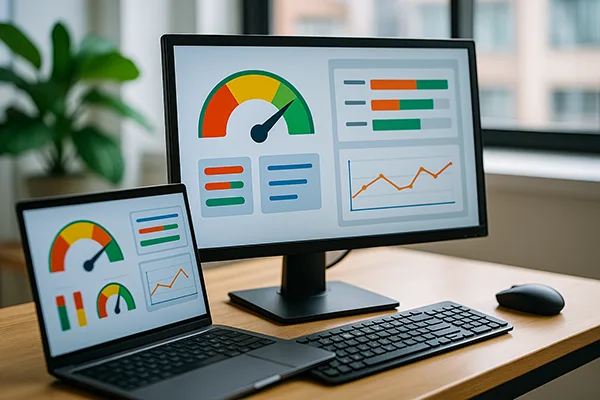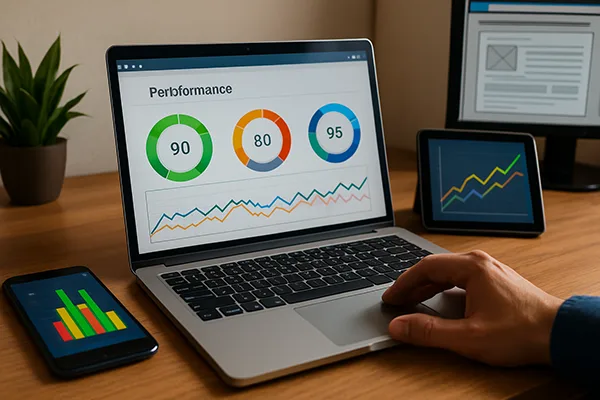
Core Web Vitals 2025: Technical SEO in Practice for Faster Rankings
Search engine optimisation (SEO) in 2025 goes far beyond traditional on-page tactics. Google now gives priority to websites offering exceptional user experiences, with Core Web Vitals playing a central role. These vital signals — LCP (Largest Contentful Paint), INP (Interaction to Next Paint, replacing FID), and CLS (Cumulative Layout Shift) — impact your site’s visibility more than ever before. In this article, we dive into actionable SEO practices using these metrics, including testing with PageSpeed Insights, Lighthouse, and WebPageTest.
Understanding the Updated Core Web Vitals Metrics
As of February 2025, Google officially replaced FID (First Input Delay) with INP (Interaction to Next Paint), a more accurate representation of responsiveness across real user interactions. INP measures the latency of all page interactions, not just the first one, giving developers better insight into the full experience. According to the Chrome UX Report, a “good” INP is under 200 milliseconds.
Alongside INP, LCP remains crucial for measuring loading speed. A site should render its largest visible element within 2.5 seconds to score well. This typically includes hero images or large text blocks. Websites exceeding this threshold often suffer drops in rankings and engagement.
CLS, or layout stability, assesses how much elements shift unexpectedly during loading. Google advises keeping CLS below 0.1. Sudden movements — such as buttons shifting positions or images loading without reserved space — hurt both the score and user trust.
How to Test Core Web Vitals Effectively
PageSpeed Insights remains one of the most reliable tools for Core Web Vitals testing. It provides real-world field data from the Chrome UX Report alongside lab data for debugging. For more comprehensive testing, developers rely on Lighthouse and WebPageTest. These tools highlight which page elements cause LCP delays or contribute to INP spikes.
Lighthouse (v11 and above) includes recommendations specific to Core Web Vitals, including resource loading order and interaction readiness. Meanwhile, WebPageTest provides filmstrip views and waterfall charts, enabling precise troubleshooting of layout instability and resource load times.
When interpreting reports, it’s crucial to test both mobile and desktop versions. In 2025, mobile performance is prioritised by Google, especially in mobile-first indexing. A desktop-optimised site may still suffer on rankings if mobile metrics are poor.
Practical Optimisation Techniques for Better Scores
To improve LCP, image optimisation is key. Use modern formats like WebP or AVIF and ensure responsive sizing with appropriate HTML attributes. Lazy loading should be used selectively; avoid it for above-the-fold content, as it can delay LCP unnecessarily.
For INP, the goal is to reduce JavaScript execution time and minimise main-thread blocking. Break long tasks into smaller chunks and defer non-critical scripts. Techniques like code splitting and using Web Workers have proven to dramatically improve interactivity scores.
CLS issues are commonly fixed by defining explicit width and height for all images, videos, and embeds. Fonts should load with `font-display: swap` to avoid invisible text during rendering. Reserve enough space for dynamic content such as banners or popups to prevent sudden shifts.
Case Studies from Real Websites
eCommerce brands like ASOS have seen measurable improvements after optimising their Core Web Vitals. By compressing hero images and preloading web fonts, they reduced LCP by 900ms across product pages, resulting in a 12% uplift in mobile traffic.
Media sites such as The Guardian deployed performance budgets and reduced JavaScript bloat, improving their INP to below 200ms. This not only enhanced responsiveness but also lowered bounce rates on article pages by nearly 15%.
Startups like Notion used lazy-loading iframes for embedded content and introduced skeleton loaders to visually stabilise their layout. As a result, CLS dropped from 0.23 to 0.07, contributing to longer session durations and increased sign-up rates.

Monitoring and Maintaining Long-Term SEO Performance
Improving Core Web Vitals isn’t a one-time task. Regular monitoring is essential, as updates to browsers, frameworks, or third-party scripts can degrade performance over time. Use tools like Google Search Console’s Core Web Vitals report to track site-wide issues.
Performance budgets should be established and enforced through continuous integration pipelines. For example, limit JavaScript to under 150KB and keep third-party scripts under control. Budget breaches should block deployments until resolved.
It’s also important to stay updated with changes to Google’s algorithm and documentation. Core Web Vitals thresholds may evolve, and new metrics could be introduced. Subscribe to Chrome Developers blog or use GitHub changelogs for real-time insights.
Why Core Web Vitals Influence Ranking in 2025
Google confirmed that Core Web Vitals are part of the page experience ranking signal. With competition intensifying in all niches, small improvements in load speed and UX can lead to noticeable ranking gains. Especially in sectors like online retail and casino platforms, even 100ms delay can impact conversion rates significantly.
UX-focused SEO aligns with Google’s mission to deliver valuable results. Optimised Core Web Vitals signal that a site is reliable, responsive, and accessible — all of which correlate with higher engagement and lower bounce rates.
Ultimately, by focusing on performance, you’re not just meeting Google’s criteria — you’re serving your audience better. A fast, stable, and responsive experience is no longer a luxury; it’s a requirement for staying competitive in 2025.



